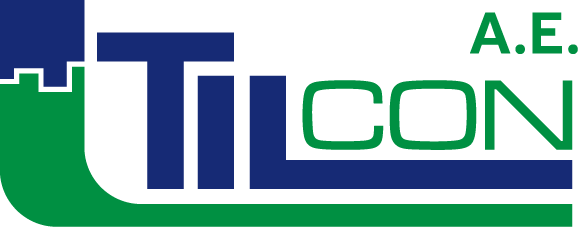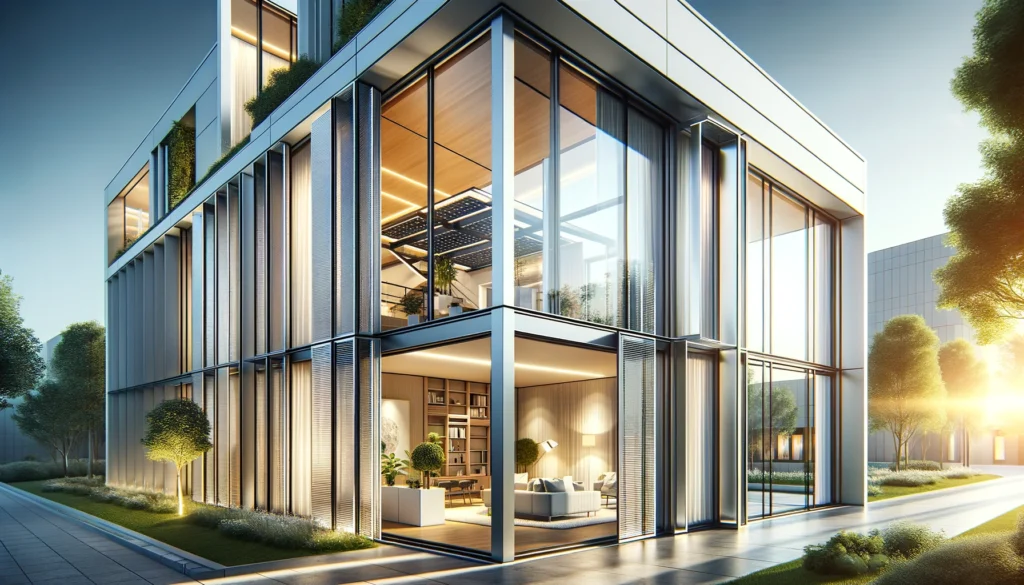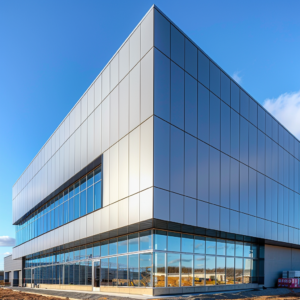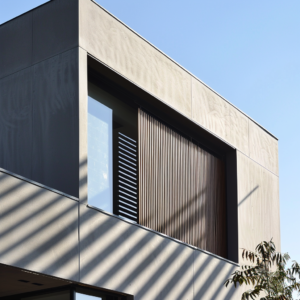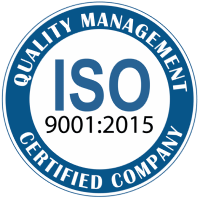Introduction to Aluminum in Construction
Historical Evolution of Aluminum Usage
Aluminum’s journey from a rare, decorative metal to a ubiquitous building material highlights human ingenuity and industrial progress. Isolated by Danish chemist Hans Christian Ørsted in 1825, aluminum was initially valued more than gold. The Hall-Héroult process in 1886 made aluminum production economically viable, transforming it into a material for widespread industrial use. Notable milestones include its use in the Empire State Building in the 1930s and post-WWII surge in construction applications due to its lightweight and corrosion-resistant properties.
Fundamental Properties and Characteristics
Aluminum’s properties make it invaluable in construction. Its low density, about one-third that of steel, simplifies handling and reduces transportation and installation costs. Despite its lightweight nature, aluminum has a high strength-to-weight ratio, providing robustness without excessive weight. It naturally forms a protective oxide layer, making it corrosion-resistant and reducing maintenance costs. Aluminum is also a good conductor of electricity and heat, which is beneficial for building integrated photovoltaics and other applications. Its recyclability significantly reduces its environmental footprint. Aluminum’s versatility and malleability allow it to be shaped into various forms, making it suitable for diverse construction applications. Its thermal properties help reduce heat gain in buildings, enhancing energy efficiency.
Comparative Analysis with Other Construction Materials
When compared to other construction materials like steel, wood, and plastic, aluminum offers several advantages. Steel, though strong and durable, is heavy and prone to corrosion. Wood is aesthetically pleasing and renewable but vulnerable to pests, fire, and rot. Plastic is lightweight and versatile but lacks the strength of metals and poses significant environmental concerns. Aluminum, with its balance of strength, lightweight properties, and corrosion resistance, stands out. Its upfront cost is higher than wood and plastic but lower than high-quality steel, with long-term savings due to its durability and low maintenance requirements. Aluminum’s recyclability and low environmental impact also make it an eco-friendly choice. Its suitability for a range of applications, from facades to structural frameworks, further emphasizes its versatility.
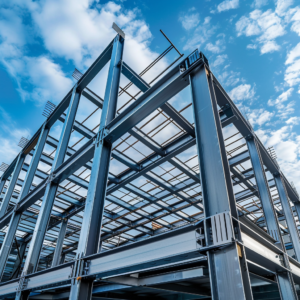
Practical Applications of Aluminum in Construction
Structural Components and Frameworks
Aluminum’s role in construction extends beyond aesthetics; it forms the backbone of modern structural engineering. Its integration into frameworks and large-scale infrastructure has revolutionized how we build, providing unparalleled strength and flexibility.
Frames and Beams:
Aluminum is extensively used in building frameworks, including frames and beams. Its lightweight nature simplifies transportation and installation, while its high strength ensures structural integrity. The ease of shaping aluminum into various forms allows for innovative architectural designs without compromising on stability.
Bridges and Towers:
Aluminum’s application in bridges and towers showcases its durability and corrosion resistance. Iconic examples include the San Francisco-Oakland Bay Bridge, where aluminum’s resilience against harsh weather conditions proves invaluable. Towers, such as communication and observation structures, benefit from aluminum’s ability to withstand environmental stressors while maintaining a lower overall weight.

The project that really brought aluminium to the attention of architects was when it was used for major structures within the Empire State Building in 1930-32. The tower structure and spire are partly built using aluminium, as are the elevator doors, decorative trim and over 6,000 window spandrels (Wikipedia).
Skyscrapers and High-Rises:
In the realm of skyscrapers and high-rises, aluminum plays a crucial role in load-bearing frameworks. Its strength-to-weight ratio allows for taller, more slender structures that maximize space and offer aesthetic flexibility. The use of aluminum in high-rise construction supports innovative designs that define modern skylines. The Lakhta Center in St Petersburg, Russia, includes a 462 m tower with an aluminum façade — making it the tallest skyscraper in Europe and the 13th tallest building in the world.
Modular and Prefabricated Structures:
Aluminum is a preferred material for modular and prefabricated structures due to its efficiency and ease of transport. Prefabricated aluminum components can be quickly assembled on-site, reducing construction time and labor costs. This approach is particularly beneficial in projects requiring rapid deployment, such as emergency shelters and temporary buildings.
Facades, Cladding, and External Surfaces
Aluminum facades and cladding have transformed the external appearance and functionality of buildings worldwide. Their ability to combine aesthetic appeal with practical benefits makes them an indispensable choice in modern construction.
The Wave is a residential development in the town of Almere, Holland designed by René van Zuuk and completed in 2004. The wave shape of the building reflects its lakeside location and is an excellent example of a modern aluminium structure. The seven storey building contains 49 apartments, all with living rooms that look out over Weerwater Lake, a small artificial lake used for recreation. Aluminium was chosen for the exterior panels because of its corrosion resistance in the salty, humid climate in an area where much of the land has been reclaimed from the sea.
Cladding and Panels:
Aluminum cladding and panels offer numerous benefits, including enhanced aesthetics, insulation, and weatherproofing. They provide a sleek, modern look that can be customized to suit any architectural style. Prominent examples include the Al Bahar Towers in Abu Dhabi, where dynamic aluminum cladding adjusts to sunlight, reducing heat gain and enhancing energy efficiency.
Aesthetics and Customization:
The design flexibility of aluminum allows architects to create visually striking facades. Its malleability means it can be molded into various shapes and finishes, accommodating innovative designs. Buildings like the Guggenheim Museum in Bilbao showcase aluminum’s potential in creating iconic structures that are both functional and artistically significant.
Insulation and Weatherproofing:
Aluminum cladding significantly improves a building’s insulation, helping maintain interior temperatures and reducing energy consumption. Advanced technologies, such as thermal breaks and insulated panels, enhance these properties further. Aluminum’s resistance to weather conditions ensures buildings remain protected from the elements, extending their lifespan and maintaining their appearance.
Maintenance and Durability:
One of the key advantages of aluminum facades is their low maintenance requirements. The natural oxide layer that forms on aluminum surfaces provides long-term protection against corrosion, reducing the need for frequent upkeep. This durability translates to cost savings and a reduced environmental impact over the building’s lifecycle.
Roofing Solutions and Insulation Materials
In modern construction, roofing and insulation play crucial roles in ensuring the durability and energy efficiency of buildings. Aluminum, with its unique properties, stands out as an exceptional material for these applications.
Aluminum Roofing Sheets and Panels:
Aluminum roofing sheets and panels are increasingly popular due to their lightweight nature, which simplifies installation and reduces structural load. These roofing solutions are not only durable but also offer superior performance in various environmental conditions. Aluminum roofs are often seen in both residential and commercial buildings, providing a sleek and modern appearance.
Energy Efficiency and Reflectivity:
One of the standout features of aluminum roofing is its high reflectivity, which helps in reducing heat gain within buildings. By reflecting a significant portion of solar radiation, aluminum roofs contribute to maintaining cooler indoor temperatures, thereby reducing the need for air conditioning and lowering energy consumption and costs.
Durability and Weather Resistance:
Aluminum’s natural resistance to corrosion and ability to withstand extreme weather conditions make it an ideal material for roofing. It can endure heavy rains, snow, and high winds without deteriorating, ensuring a long lifespan with minimal maintenance. This durability translates to fewer repairs and replacements over the building’s lifecycle.
Cost-Effectiveness and Installation:
While the initial cost of aluminum roofing might be higher compared to traditional materials, its long-term benefits make it a cost-effective choice. The ease of installation reduces labor costs, and its longevity ensures savings on maintenance and replacement. Overall, aluminum roofing provides an excellent return on investment, balancing upfront costs with long-term savings.

Windows, Doors, and Architectural Elements
Aluminum has become a staple in modern architecture, particularly in the design and construction of windows, doors, and other architectural elements. Its combination of durability, aesthetics, and energy efficiency makes it an ideal material for these applications.
Aluminum Window Frames:
Aluminum window frames are prized for their durability and sleek design. They incorporate thermal break technology, which significantly improves their insulating properties by reducing heat transfer. This makes aluminum windows not only stylish but also energy-efficient, helping to lower heating and cooling costs. Examples include double-glazed windows with aluminum frames, which are common in modern energy-efficient buildings.
Doors and Entryways:
Aluminum doors offer unparalleled strength and security while maintaining a lightweight structure. This balance makes them ideal for both residential and commercial entryways. The material’s design flexibility allows for various styles and finishes, enabling customization to match any architectural vision. From sleek, minimalist designs to robust, security-focused doors, aluminum caters to a wide range of needs.
Architectural Elements:
Beyond windows and doors, aluminum is used in a variety of architectural elements, including railings, balustrades, and decorative facades. Its versatility allows for intricate designs and innovative solutions that enhance both the functionality and aesthetic appeal of buildings. Notable examples include the modern, clean lines seen in many contemporary high-rise buildings and public structures.
Energy Efficiency and Noise Reduction:
Aluminum windows and doors contribute to a building’s overall energy efficiency. The insulating properties of aluminum, especially when used with double-glazing and thermal breaks, reduce heat loss in the winter and heat gain in the summer. Additionally, these features provide excellent noise reduction, creating quieter, more comfortable indoor environments.
Advantages of Utilizing Aluminum in Construction
Environmental Sustainability and Impact
Sustainability is at the forefront of modern construction, and aluminum plays a pivotal role in achieving eco-friendly building practices. From green architecture to resource efficiency, integrating sustainable methods with aluminum can significantly enhance the environmental performance of buildings.
Recyclable and Eco-Friendly:
Aluminum is highly recyclable, with nearly 75% of all aluminum ever produced still in use today. The recycling process consumes only 5% of the energy required to produce primary aluminum, making it an eco-friendly choice. Using recycled aluminum in construction projects reduces the environmental impact significantly while maintaining material quality and strength.
Carbon Footprint and Lifecycle Analysis:
Throughout its lifecycle, aluminum boasts a lower carbon footprint compared to many other construction materials. From extraction to end-of-life recycling, the energy efficiency of aluminum production has improved, further reducing its environmental impact. Lifecycle analysis shows that aluminum, particularly when recycled, offers substantial environmental benefits over materials like steel and plastic.
Green Building Certifications:
Aluminum contributes significantly to achieving sustainable building certifications like LEED (Leadership in Energy and Environmental Design). Its properties, such as recyclability, energy efficiency, and minimal maintenance, align with the criteria for sustainable building practices. Buildings like the Edge in Amsterdam, renowned for its sustainability, heavily incorporate aluminum in their design, showcasing its role in green architecture.
Waste Reduction and Resource Efficiency:
The use of aluminum in construction minimizes waste due to its recyclability and the efficiency of its production process. Modern manufacturing techniques ensure that aluminum is used optimally, reducing excess and waste. Additionally, aluminum’s lightweight nature reduces transportation energy, contributing to overall resource efficiency.
Longevity, Durability, and Maintenance
The durability and low maintenance of construction materials are critical factors in ensuring the long-term success and cost-effectiveness of a building. Aluminum excels in these areas, offering both longevity and minimal upkeep.
Longevity:
Aluminum structures are known for their long lifespan. The material’s inherent resistance to corrosion and wear means that buildings constructed with aluminum can remain functional and aesthetically pleasing for decades. Iconic structures like the Empire State Building, which incorporates aluminum in its design, stand as testaments to the material’s enduring nature.
Durability:
Aluminum’s durability is one of its most significant advantages. It withstands harsh environmental conditions, including extreme temperatures, moisture, and pollution, without deteriorating. This resilience ensures that aluminum components maintain their structural integrity over time, reducing the need for repairs and replacements.
Low Maintenance Requirements:
One of the standout benefits of aluminum in construction is its minimal maintenance needs. The natural oxide layer that forms on aluminum surfaces protects against corrosion and eliminates the need for frequent painting or sealing. This characteristic not only saves on maintenance costs but also reduces the time and effort required to keep buildings in top condition.
Case Studies:
Buildings like the John Hancock Tower in Boston and the Alcoa Building in Pittsburgh illustrate aluminum’s longevity and durability. These structures have withstood the test of time, maintaining their functionality and appearance with minimal maintenance, highlighting aluminum’s role in sustainable and cost-effective construction.
Economic Benefits and Cost-Effectiveness
Choosing the right construction material can have a profound impact on the economic viability of a project. Aluminum stands out not only for its superior properties but also for its economic benefits, offering a compelling case for cost-effectiveness in construction.
Initial Cost vs. Long-Term Savings:
While aluminum may have a higher initial cost compared to some traditional materials, the long-term savings it offers are substantial. Aluminum’s durability and low maintenance requirements reduce the need for frequent repairs and replacements, ultimately lowering the total cost of ownership. Projects that invest in aluminum often see significant savings over time, making it a cost-effective choice.
Return on Investment (ROI):
The return on investment (ROI) for aluminum in construction is notable. Buildings constructed with aluminum components typically enjoy extended lifespans, reduced maintenance costs, and enhanced energy efficiency, all of which contribute to a higher ROI. For example, the use of aluminum in the roofing and cladding of the Edge building in Amsterdam has resulted in significant energy savings and low operational costs, exemplifying a high ROI.
Efficiency and Value:
Aluminum’s efficiency in the construction process is another economic benefit. Its lightweight nature reduces transportation costs and simplifies installation, leading to faster project completion times. Additionally, aluminum adds value through its longevity and resilience, ensuring that structures maintain their integrity and aesthetic appeal over decades.
Budget-Friendly Options:
Despite its high initial cost, aluminum can be an affordable option in the long run. Its versatility allows for its use in various budget-friendly applications, such as modular and prefabricated structures, which benefit from aluminum’s ease of assembly and durability. This balance of quality and cost makes aluminum a viable option for a wide range of construction projects, from high-end to cost-sensitive developments.
Design Versatility and Aesthetic Flexibility
Aluminum’s design versatility and aesthetic flexibility make it an invaluable material in the hands of architects and designers. Its adaptability and ease of customization allow for innovative and practical designs that enhance the functionality and beauty of modern structures.
Adaptability and Customization:
Aluminum’s malleability allows it to be easily shaped and customized to fit a wide range of architectural styles and requirements. This adaptability is particularly valuable in creating unique, bespoke designs that stand out. For instance, the fluid, curvilinear forms of the Guggenheim Museum Bilbao’s exterior demonstrate aluminum’s potential in creating striking architectural statements.
Multi-Functional Applications:
Aluminum is used in various architectural elements, from facades and cladding to roofing and structural components. Its multi-functional nature allows it to serve both aesthetic and practical purposes, providing strength and durability while enhancing visual appeal. This versatility makes it an excellent choice for architects seeking to balance form and function.
Innovative and Practical Designs:
Innovations in aluminum design continue to push the boundaries of what is possible. Advances in manufacturing and fabrication techniques have enabled the creation of complex geometries and intricate details that were previously difficult to achieve. Practical applications, such as aluminum curtain walls and intricate lattice structures, highlight the material’s ability to deliver both beauty and functionality.
Case Studies and Examples:
Notable buildings like the Walt Disney Concert Hall in Los Angeles and the Hearst Tower in New York showcase aluminum’s design flexibility. The concert hall’s undulating aluminum panels create a dynamic and captivating facade, while the Hearst Tower’s triangular grid exoskeleton demonstrates aluminum’s structural and aesthetic capabilities. These examples underscore aluminum’s role in modern architectural innovation.
Cutting-Edge Technological Innovations
Aluminum continues to evolve with cutting-edge technological innovations that enhance its applications in construction. These advancements are driving the industry forward, making aluminum an even more versatile and valuable material.
Innovative Manufacturing Processes:
Recent advancements in manufacturing processes have revolutionized aluminum production and fabrication. Techniques such as 3D printing and advanced extrusion allow for more complex and precise aluminum components. These innovations enable the creation of custom shapes and structures that were previously difficult or impossible to achieve, expanding the possibilities for aluminum in construction.
Modern Applications and Enhancements:
The integration of smart technologies and automation in aluminum applications is transforming the construction industry. Smart facades, for example, incorporate sensors and automated systems to optimize energy efficiency and indoor climate control. Automated assembly techniques streamline the construction process, reducing labor costs and improving precision.
New Materials and Composites:
The development of new aluminum alloys and composites is enhancing the material’s properties. These innovations offer improved strength and reduced weight, making aluminum even more suitable for demanding applications. For instance, aluminum-lithium alloys are now used in aerospace and high-performance engineering projects, demonstrating the potential for these materials in construction.
Future Trends and Research:
Emerging trends in aluminum technology point to even greater innovations on the horizon. Ongoing research focuses on improving the sustainability and performance of aluminum, with potential applications in renewable energy systems and advanced construction
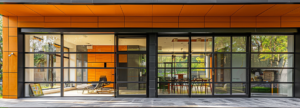
Future Trends and Innovations in Aluminum Construction
Novel and Emerging Applications
Aluminum’s versatility drives innovation in the construction industry, with novel applications shaping the future of building design. Aluminum foam panels offer lightweight yet sturdy construction materials with excellent thermal and acoustic insulation properties. 3D-printed aluminum components enable the creation of complex and custom structures with high precision and efficiency. Future potential includes aluminum in photovoltaic panels for integrated solar energy solutions and aluminum-based nanomaterials for self-cleaning and self-repairing surfaces. These emerging applications promise to transform construction by improving efficiency, sustainability, and design flexibility.
Market Growth and Future Prospects
The aluminum construction market is expanding rapidly, driven by urbanization, sustainability demands, and technological advancements. Urbanization and sustainability are key drivers, with aluminum’s recyclability and energy efficiency aligning well with green building practices. Future trends include increased use of aluminum in green building projects and high-rise construction. Emerging markets, particularly in countries undergoing rapid urbanization like India and China, present significant investment opportunities. Despite challenges such as fluctuating raw material prices, strategic planning and innovation can overcome these obstacles, ensuring continued growth in the aluminum construction market.
Integrating Sustainable Construction Practices
Sustainability is a crucial aspect of modern construction, with aluminum playing a vital role in eco-friendly building practices. Green architecture emphasizes environmentally friendly materials and energy-efficient designs, with aluminum aligning perfectly with these principles. Aluminum supports the use of renewable resources by reducing the need for new raw materials, conserving natural resources and reducing environmental impact. Aluminum’s low environmental footprint and high resource efficiency make it ideal for sustainable construction. Its contribution to achieving sustainable building certifications like LEED demonstrates its role in green building practices.
Conclusion
Aluminum has established itself as a cornerstone of modern construction due to its exceptional properties and versatility. Its journey from a precious metal to a widespread industrial material underscores significant technological advancements.
Lightweight nature, high strength-to-weight ratio, corrosion resistance, and recyclability make it an invaluable material in construction. It offers superior performance in structural frameworks, facades, cladding, roofing, and architectural elements, balancing aesthetics and practicality.
Aluminum’s economic benefits, including long-term savings and high return on investment, further enhance its appeal. As construction trends shift towards sustainability, aluminum’s eco-friendly attributes and low environmental impact position it at the forefront of green building practices.
Cutting-edge innovations and emerging applications promise to expand aluminum’s role in the industry, driving future growth and technological advancements.
Aluminum’s continued evolution and integration into sustainable construction practices ensure its significance in building resilient, efficient, and aesthetically pleasing structures.

